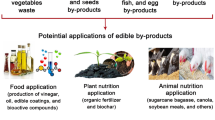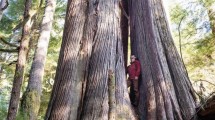Abstract
Beavers store and consume tree parts in the bodies of water where they live. We examined whether such soaking renders food more palatable by leaching out undesirable compounds. In experiment 1, saplings of red maple, Acer rubrum (RM), were first soaked in a pond for periods of 2, 18, and 36 days, then offered to free-ranging beavers. Soaking for two days rendered RM slightly more acceptable to beavers. To further examine the time window around two days, RM sticks were soaked in distilled water in the laboratory for 1, 2, 4, and 6 days before presenting them to beavers (experiment 2). In experiment 3, twigs of three species were placed on land. Beavers placed RM in the water for 1 to 3 days before consuming the twigs. In experiment 4, sticks were provided in the water at Cranberry Lake Biological Station (CLBS). Most quaking aspen (QA) was consumed during the first night, and most witch hazel, Hamamelis virginiana (WH), during the third night. At Allegany State Park (ASP), no such difference was found. Twigs were provided in the water in experiment 5. At ASP, WH was taken after three days in the water, and at CLBS little WH was consumed, and only during the third night. A meta-analysis of all experiments shows that relatively more WH is consumed after two days than any other species. Experiment 6 traced the time beavers left their own harvested branches in the water. Unlike other tree species, WH remained in the water for two to four days before being consumed. Experiment 7 measured the phenolics leached into water from RM twigs and small pieces of bark soaked for 10 and 8 days, respectively. Shredded bark lost 50–60% of leachable phenolics into the water, and twigs 70–80%. We conclude that beavers can use water to leach undesirable compounds from their food. Although this effect was not robust, our study is the first of its kind.
Similar content being viewed by others
REFERENCES
ABOU-ZAID, M. M., GRANT, G. G., HELSON, B. V., BENNINGER, C. W., and DE GROOT, P. 2000. Phenolics from deciduous leaves and coniferous needles as sources of novel pest control agents for lepidopteran forest pests, pp. 398-416, in F. Shahidi and C.-T. Ho (eds.). Phytochemicals and Phytopharmaceuticals. AOCS Press, Champaign, Illinois.
BARBOSA, P., GROSS, P. PROVAN, G. J., PACHECO, D. Y., and STERMITZ F. R. 1990. Allelochemicals in foliage of unfavored trees of the gypsy moth. J. Chem. Ecol. 16:1719-1730.
BOX, J. D. 1983. Investigation of the Folin-Ciocalteau phenol reagent for the determination of polyphenolic substances in natural waters. Water Res. 17:511-525.
BUSHER, P. E. 1991. Food caching behaviour by the North American beaver, Castor canadensis, in western Massachusetts, pp. 111-114 in B. Bobek, K. Perzanowski, and W. L Regelin (eds.). Transactions Eighteenth IUGB Congress, Krakow 1987, Vol. 1. Swiat Press, Krakow.
BUSHER, P. E. 1996. Food caching behavior of beavers (Castor canadensis): Selection and use of woody species. Am. Midl. Nat. 135:343-348.
DEARING, M. D. 1997. The manipulation of plant toxins by a food-hoarding herbivore, Ochotona princeps. Ecology 78:774-781.
DIXON, M. D., JOHNSON, W. C., and ADKISSON, C. S. 1997. Effects of caching on acorn tannin levels and Blue Jay dietary performance. Condor 99:756-764.
DOUCET, C. M., and FRYXELL, J. M. 1993. The effect of nutritional quality on forage preference by beavers. Oikos 67:201-208.
FRYXELL, J. M., and DOUCET, C. M. 1993. Diet choice and the functional response of beavers. Ecology 74:1297-1306.
JENKINS, S. H. 1980. A size-distance relation in food selection by beavers. Ecology 61:740-746.
JOHNS, T. 1990. With Bitter Herbs They Shall Eat It: Chemical Ecology and Origins of Human Diet and Medicine. University of Arizona Press, Tucson.
MüLLER-SCHWARZE, D., and SCHULTE, B. A. 1999. Behavioral and ecological characteristics of a “climax” population of beaver (Castor canadensis), pp. 161-177, in Beaver Protection, Management and Utilization in Europe and North America. P. Busher and R. Dzieciolowski (eds.). Kluwer/Plenum, New York.
MüLLER-SCHWARZE, D., SCHULTE, B. A., SUN, L., MüLLER-SCHWARZE, C., and MüLLER-SCHWARZE, A. 1994. Red maple (Acer rubrum) inhibits feeding by beaver (Castor canadensis). J. Chem. Ecol. 20:2021-2034.
O'BRIEN, J. P. 1981. Summer food habits of the mountain beaver in northeastern California. Murrelet 62:86-87.
ROY, J., and BERGERON, J. 1990. Branch-cutting behavior by the vole Microtus pennsylvanicus: A mechanism to decrease toxicity of secondary metabolites in conifers. J. Chem. Ecol. 16:735-741.
ROZE, U. 1989. The North American Porcupine. Smithsonian Institution Press, Washington, D. C.
SHADLE, A. R., and AUSTIN, T. S. 1939. Fifteen months of beaver work at Allegany State Park. J. Mammal. 20:299-303.
SHURE, D. J., and WILSON, L. A. 1993. Patch-size effects on plant phenolics in successional openings of the southern Appalachians. Ecology 74:55-67.
Author information
Authors and Affiliations
Rights and permissions
About this article
Cite this article
Müller-Schwarze, D., Brashear, H., Kinnel, R. et al. Food Processing by Animals: do Beavers Leach Tree Bark to Improve Palatability?. J Chem Ecol 27, 1011–1028 (2001). https://doi.org/10.1023/A:1010347306023
Issue Date:
DOI: https://doi.org/10.1023/A:1010347306023




